|
Food and drink biodiversity:
Vegetables
The vegetables listed below are mainly ones that can be
purchased in shops in southern Africa. See also
Wild Vegetables. Vegetables from leaves
|
Allium schoenoprasum (Chives)
Native to Europe and Asia and believed to have been
domesticated within the Mediterranean region. The earliest records of
cultivated chives go back to only the 16th century. The leaves of chives are
have a mild flavour and are cut up and added to salads, egg dishes, meat
dishes, sauces and cottage cheese. |
|
|
Beta vulgaris var.
cicla (Swiss chard,
Leaf Beet, Spinach beet)
All the varieties of Beta vulgaris (Chard,
Beetroot, Sugarbeet, Mangel-wurzel) ultimately originate from wild Sea Beet
Beta maritima which is native to the Mediterranean and the
Atlantic seaboard of Europe. Swiss chard is a leafy variety, cooked
like spinach and referred to, incorrectly, as spinach in South
Africa. It was referred to by Aristotle in about 350 BC and was
probably cultivated well before this. Rich in minerals (particularly
magnesium but also calcium, iron, phosphorus and potassium) and also
vitamins (particularly Vitamin A). |
 |
|
Brassica
oleracea (Cabbage, Brussels sprouts, Kale, Kohlrabi)
Family: Brassicaceae
Brassica oleracea originates from the Atlantic seaboard of
Europe and the Mediterranean. It has been used as a vegetable for more
than 2500 years and through selective breeding for particular
characteristics of the plant, six main vegetables have been produced
from this one species. (See also under Vegetables from flowers). |
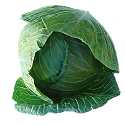 |
|
Cichorium endivia (Endive)
Family: Asteraceae
Leaves have been used in salads since at least Greek and Roman times.
Closely related to Chicory Cichorium intybus, but distinguished
mainly by being annual rather than perennial. |
|
|
Cichorium intybus
(Belgium endive, Chicory)
Originates in Europe and western Asia. There are
three main varieties: Wild chicory is a weed (including in southern Africa)
and has medicinal properties, Belgium endive is eaten in a similar way to
lettuce, and the roots of Coffee chicory are used as a coffee additive or
substitute. |
|
|
Cynara cardunculus (Cardoon)
Family: Asteraceae
The fleshy leaf bases are eaten as a vegetable and
the dried flowers are used for curdling milk. Originates from southern
Europe and Northwest Africa. In the same tribe of the daisy family as
thistles. |
|
|
Lactuca sativa (Lettuce)
Family: Asteraceae
Lettuce originates from the wild Lactuca serriola
found in the Mediterranean and Near East and has been transformed from an
erect plant with bitter leaves to various cultivars including ones with
distinctive heads of chlorophyll deficient leaves. |
 |
|
Rheum x cultorum
(Rhubarb)
The maroon-coloured leaf-stalks are stewed and eaten as a
pudding. |
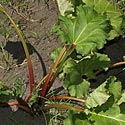 |
|
Rorippa
nasturtium-aquaticum (Watercress)
Family: Brassicaceae
Watercress is native to Europe where it grows in streams, ditches,
springs and fast-flowing waters. It has been used as a salad plant since
at least Roman times and the first records of it being grown
commercially date back to 1750 in Germany. Besides being used in salads,
it is put in sandwiches and used in soups and oriental stir-fry dishes.
It has a fresh, clean peppery taste. |
|
|
Spinacea oleracea (Spinach)
Family: Amaranthaceae
Appears to have been selectively cultivated from Spinacea tetrandra
which is native to the mountainous regions of southwestern Asia (the
Himalayas and Afghanistan). The first known record of using Spinach as a
vegetable dates back to China in the 7th to 8th centuries AD and the
first record of its use in Europe dates to the 1200's |
|
Rarely used leafy vegetables
include
Atriplex hortensis (Orache),
Basella alba (Malabar spinach,
Ceylon spinach)
Vegetables from shoots
|
Apium graveolens
(Celery)
Family: Apiaceae
Native to Europe and Asia. Cultivation of celery was
undertaken by the Chinese, Egyptians, Greeks and Romans and three main
varieties were developed: Chinese celery, stalk celery and celeriac.
Stalk celery is the main variety used in southern Africa and typically
is used in salads and in soups.
|
 |
|
Asparagus officinalis
(Asparagus)
Family: Asparagaceae
Originates from Europe. Served as a delicacy
in Greek and Roman times. Young shoots are cooked and eaten. The smell in
one’s urine after eating asparagus is caused by excretion of the
substance methyl mercaptan.
|
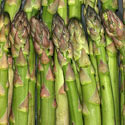 |
|
Cichorium intybus
(Chicory)
Family: Asteraceae
Eaten raw (eg. in salads), or braised or fried. Root
used as substitute for coffee. Originates from Europe and western Asia.
|
|
Vegetables from shoots that are rarely eaten in southern
Africa include: palm hearts, which are young shoots harvested from
Bactris gasipaes (Pejibaye,
Peach palm).
Vegetables from flowers
|
Brassica oleracea
(Brocolli, Cauliflower)
Family: Brassicaceae
Brassica oleracea has been bred into six main
vegetables, four of them derived from the leaves (cabbage, Brussels
Sprouts, Kale and Kohlrabi) and two of them derived from the flowers
(Brocolli, Cauliflower). |
 |
|
Cynara scolymus
(Globe artichoke)
Family: Asteraceae
The flowerhead is eaten as a vegetable. A cultigen
species, probably derived from the Cynara carduncellus (Cardoon) which
originates from southern Europe and North Africa.
|
|
Vegetables from fruit
|
Abelmoschus esculentus (Okra, Lady's fingers, Gumbo)
Believed to be native to tropical West Africa and is
cultivated for the young fruit, which are eaten as a vegetable. It is cultivated
on a small scale in southern Africa and is known to grow wild in this region. |
|
|
Capsicum annuum
(Sweet
and Chili Pepper)
Family: Solaneae
Peppers orginate from Central America where most of
the main varieties were developed by local Indians. Once peppers were
discovered by the Spaniards and Portuguese they were rapidly introduced
worldwide and eagerly incorporated into local cuisines. Sweet peppers can be eaten raw or cooked; chilli or hot
pepper are used in seasoning. |
 |
|
Cucumis anguria (Gherkin,
West Indian gherkin)
Family: Cucurbitaceae
The Gherkin originates from southwestern Africa and the
wild form (bitter with spikey fruit, leaves and stems) is widely
distributed in the northern parts of southern Africa. The Gherkin is
thought to have been brought to the West Indies in the slave trade days
(probably from Angola), where it became popular as a vegetable. The most
common use of gherkins is to pickle them when young but they also boiled
fresh and eaten as a vegetable. Most so-called pickled gherkins sold in
shops in southern Africa are in fact baby
cucumbers.
Nutritionally gherkins have some minerals and vitamins but nothing in
large amounts. |
|
|
Cucumis sativus
(Cucumber)
Family: Cucurbitaceae
Originates from a wild species growing in India that was domesticated more
than 2000 years ago. Cucumbers today are mainly grown in hothouses. They are
usually eaten sliced in salads or on sandwiches but are also blended up
for cold sauces and soups. Less commonly, they are used in cooked
dishes. Young cucumbers are pickled as gherkins (see true
Gherkin). |
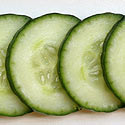 |
|
Cucurbita moschata
(Butternut)
Family: Cucurbitaceae
Cucurbita moschata was domesticated from a wild species in the region
from southern Mexico to northern and western South America. Archaeological
remains dating to about 2000 BC have been found in Peru. There are varieities
other than Butternut but the latter is the most commonly encountered in
southern Africa. Butternut is cooked and eaten as a vegetable and is
commonly made into a tasty soup. |
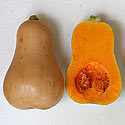 |
|
Cucurbita maxima
(Hubbard
Squash, Winter squash)
Family: Cucurbitaceae
Cucurbita maxima originates from temperate South America where it was
domesticated from Cucurbita andreana which is native to Argentina and
Uruguay. The earliest archaeological remains are from 1800 BC in Peru. There are
a wide variety of cultivars with Hubbard being the most commonly
encountered in southern Africa. Varieties of Cucurbita maxima can
be distinguished from those of Cucurbita pepo by soft rounded
stems, not angular and bristly. Fruit have high levels of minerals and
Vitamin A. |
|
|
Cucurbita
pepo (Pumpkin, Gem
Squash, Marrow,
Courgette)
Family: Cucurbitaceae
Cucurbita pepo
was domesticated in North America from wild Cucurbita
texana, occurring in the south central USA, and Cucurbita fraterna,
occurring in northeastern Mexico. It has angled stems with prickles whereas
those of
Cucurbita maxima (Pumpkin, Hubbard squash) are soft and rounded. From archeological excavations in Mexico,
domestication can be dated back to about 8000 BC. Squashes were introduced to
Europe by returning Spanish explorers in the 1500's. They are eaten cooked as a
vegetable. The seeds are nutritious in that they are rich in zinc and
omega 3 oils. |
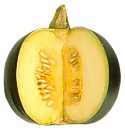 |
|
Hibiscus esculenta
(Okra)
Family: Malvaceae
The young fruit are eaten as a vegetable. They are
very mucilaginous which gives soups and caseroles a thick consistency.
Okra is tropical in origin but there is uncertainty whether it was
domesticated in Africa or India. |
|
|
Lycopersicon esculentum
(Tomato)
Family: Solaneae
Tomatoes originate in South America and were
domesticated in Mexico. They were introduced to Europe by the Spaniards in
the 1500's and were initially regarded with grave suspicion because of the
reputation of Solanum-like fruit as being poisonous. Even by 1800,
people in northern Europe were anti-tomato whereas in Spain it had become
the most commonly eaten vegetable. |
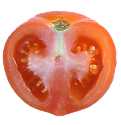 |
|
Olea europaea
(Olive)
Family: Oleaceae
Olives stones have been found in
archaeological sites dating as far back as 9000 BC, although only from
about 3500 BC is there clear evidence of domestication (in the
Mediterranean region). In order to make olives palatible, they need to be
soaked in alkali liquid to extract a bitter glucoside they contain. |
|
|
Persea americana
(Avocado)
Family: Lauraceae
Native to Central and South America. It was being eaten by people more
than 9000 years ago but was domesticated only about 2500 years ago. The
name 'Avocado' and comes from the Aztec name meaning 'testicle tree'. It
is a nutritious fruit with high levels of mainly unsaturated oils,
minerals, vitamins and reasonable levels of protein. |
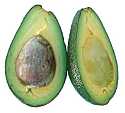 |
|
Solanum melongena
(Aubergine / Egg plant
/ Brinjal)
Family: Solaneae
Origin India. Introduced into Spain and northern Africa by arab traders in
the Middle Ages, by the 15th century was established in Italy and in
France by the 18th century. Uses Cooked as a vegetable, eg. in
ratatouille. Has a very spongy texture so that when you fry it, it soaks
up vast quantities of oil. However, once the heat reaches a certain level,
the spongy structure collapses and much of the oil is removed. |
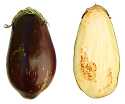 |
|
Zea mays
(Maize, Mielie, Corn)
Corn eaten on the cob classifies as a vegetable but
processed off the cob it can be regarded as a grain. Maize was domesticated in Mexico about
7000 years ago and by the time Columbus
arrived in the New World, there were already many varieties. It was introduced
to Africa in the 16th century and over time came to replace
sorghum as the staple
food in all but the drier areas. |
|
Vegetables from bulbs
|
Allium cepa
(Onion,
Spring Onion, Shallot)
Family: Alliaceae
Domesticated as a vegetable that is eaten raw or
cooked. Exact origins uncertain but thought to have been domesticated from
one or more species in Central Asia.
|
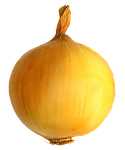
|
|
Allium porrum
(Leek)
Family: Alliaceae
The swollen, overlapping leaf bases of the Leak are eaten
cooked as a vegetable. The Leek originates from the wild species Allium
ameloprasum which occurs from Portugal and North Africa eastwards to
Turkey, Iran and about Tajikistan. |
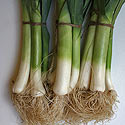 |
|
Allium sativum
(Garlic)
Family: Alliaceae
Garlic is grown as a vegetable and is also used for
medicinal purposes because of its natural antibacterial and antifungal
properties. Allium sativum is a domesticated species, thought
to have originated from Allium longicuspis which is native to
Central Asia. Evidence from Egyption tombs shows that domestication of
garlic goes back to at least 3200 BC.
|
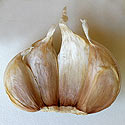 |
Vegetables from roots and tubers
|
Armoracia rusticana
(Horseradish)
Family: Brassicaceae
Horseradish is a pungent herb, with leaves that are
used in salads and sandwiches, and roots that are used for sauces that are
added to meat. It is also used for various medical complaints. It is
native to southern Russia and Eastern Ukraine. It has become naturalised
in Europe, North America and New Zealand, where it can be found growing
along roadsides. Cultivation dates back only to about Roman and Greek
times, about 2000 years ago.
|
|
|
Beta vulgaris var. esculenta
(Beetroot)
Family: Amaranthaceae
All the varieties of Beta vulgaris (Chard,
Beetroot, Sugarbeet, Mangel-wurzel) ultimately originate from wild Sea
Beet Beta maritima which is native to the Mediterranean and the
Atlantic seaboard of Europe. Eaten in Roman times at
which time it was a long, white root. The swollen red root originated in
about the mid 1500's. Its colour is the result of high
concentrations of red betalains (nitrogen-containing pigments). If a person is
doubly recessive for a certain gene, s/he is unable to break down this
pigment and it is passed in the urine. Beetroot contains high levels of
magnesium and manganese. |
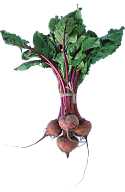 |
|
Brassica campestris
(Turnip)
Family: Brassicaceae
Turnip is a variety of Brassica campestris
with a swollen root that is eaten cooked at a vegetable. Brassica campestris is
native to Europe and Asia and was grown from at least
3500 years ago as an oilseed crop in India. In Roman times, the Gauls and other
European groups were growing turnips and this vegetable had probably been grown in this region
much earlier than this. Turnips were
also grown for feeding livestock.
|
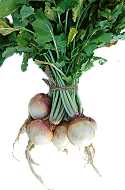 |
|
Colocasia esculenta (Elephant's
Ear, Taro Potato, Cocoyam)
Family:
Araceae
This member of the Arum Lily family orginates from India
and has tubers that are cooked and eaten in a similar manner to
potatoes. It has
been under cultivation in Southeast Asia for about 10 000 years and is now grown
widely in tropical and subtropical parts of the world. It has been cultivated in
suitable parts of southern Africa for centuries and was possibly first introduced here by
Portuguese traders before 1500. It grows best in moist heavy soils and
plants take 5-10 months to reach maturity. The tubers contain mainly
starch but also have good levels of vitamin C, phosphorus and iron.
|
|
|
Daucus carota
(Carrot)
Family: Apiaceae
Vegetable, eaten raw or cooked. Rich in carotene which is
the precursor of vitamin A. First domesticated in Afganistan. Early varieties had
anthocyanin pigments in them giving the carrot a red, purple or black colour. A
yellow variety without anthocyanin arose in the 16th century and became popular.
In the 17th century in Holland the familiar orange variety rich in carotene was
produced.
|
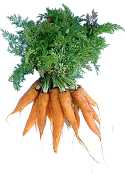 |
|
Helianthus tuberosus (Jerusalem artichoke)
Family: Asteraceae
The tuber is eaten cooked in casseroles and sauces or
eaten raw in salads. Originates from North America. Introduced to Europe in the 17th century.
|
|
|
Arctium lappa (Burdock, Gobo)
Native to Europe and introduced to Asia
and North America. Young roots are eaten as a vegetable, like carrots,
mainly in Japan (where it is called Gobo). They are also grated into stews
and sliced into stir fries. In France and Italy, young shoots and leaves are
added to soups. Cultivated mainly as a vegetable crop, particularly in
Japan. Has been cultivated in southern Africa, but not well known here.
|
|
|
Ipomoea batatas
(Sweet potato)
Family: Convolvulaceae
Sweet potatoes fall within the same genus as Morning
Glory and originate from Central and South America where they were already
being cultivated by 2500 BC.
|
|
|
Manihot esculenta
(Cassava)
Family: Euphorbiaceae
Originates from Central America. Tapioca is
manufactured from the starchy tuber. It can also be used to produce an
alcoholic drink and to make flour. The leaves can be eaten as a vegetable.
|
|
|
Pastinaca sativa
(Parsnip)
Family: Apiaceae
The Parsnip is in the same family as the Carrot (Apiaceae)
and like carrots it is biennial producing a long edible tapering root in
its first year and then flowering the following year. Wild Parsnip is
native to central and southern Europe. The origin and date of
domestication of Parsnip is uncertain.
|
|
|
Raphanus sativus
(Radish)
Family: Brassicaceae
Early cultivars of Radish were elongate and black
rather than round and red. Radish is thought to have been domesticated in
the eastern Mediterranean, prior to 2780 BC. Radish is normally eaten raw
in salads, but in Asia it is also cooked and a special variety has been
developed with long seed pods that are eaten.
|
 |
|
Solanum tuberosum
(Potato)
Family: Solanaceae
Potatoes originate from South America where people
have been cultivating them for more than 4000 years. They consist mainly
of starch but also have at least 3% protein and some vitamin C. The green
tissues in green potatoes contain substances called alkaloids which when
consumed in large quatities are poisonous.
|
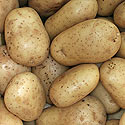 |
Publications
- Phillips, R. & Rix, M. 1993. Vegetables.
Pan Books, London.
- Sauer, J.D. 1993. Historical geography of
crop plants - a select roster. CRC Press, Boca Raton, Florida.
- van Wyk, B.-E. 2005. Food Plants of the World -
Identification, Culinary Uses and Nutritional Value. Briza, Pretoria.
- Kruger, M., Sayed, N., Langenhoven, M. and Holing, F. 1998. Composition
of South African Foods: Vegetables and Fruit. Tygerberg, Medical Research
Council.
Links
Text by Hamish G. Robertson |
